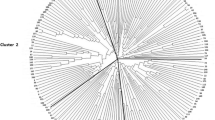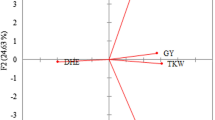Abstract
Variable results have been obtained in different crop species using geneticsimilarity (GS) estimates based on molecular markers and coefficient ofparentage (COP) to predict heterosis.This study was designed: i) to assess the level of GS among 40 breadwheat (Triticum aestivum L.) cultivars selected in Central and SouthEurope; ii) to compare GS with COP; iii) to correlate the estimates ofparental diversity with the heterotic effects detected on 149 F1hybrids obtained by crossing the 40 cultivars according to three matingdesigns.The parental cultivars and the F1 hybrids were grown in severallocations at normal seed density. Significant heterotic effects were detectedfor grain yield and other traits including quality attributes. The parentalcultivars were assayed for DNA polymorphisms using two classes ofmarkers: 338 RFLP and 200 AFLP® bands were scored. GS estimates werecomputed considering each molecular marker set separately (GSRFLP,GSAFLP) and together (GSTOT). Ample differentiation amongthe parental cultivars was detected with the two marker sets. Although theaverage GSTOT (0.43) was higher than COP (0.10), the twomeasurements were significantly correlated (r = 0.36, p < 0.01).Correlations between the different estimates of genetic diversity andF1 performance or mid parent heterosis for grain yield and otherrelated traits were in general low although statistically significant.A more detailed analysis was conducted on 28 F1 hybridsproduced in a half diallel cross of eight parental cultivars characterized byhigh heterotic effects for grain yield. The GS estimates based on RFLP,AFLP® markers and also on RAPD were partitioned into general andspecific components. Correlations with general and specific combiningability effects for the measured traits were in several cases statisticallysignificant but too low to be predictive and therefore exploitable in practicalbreeding.
Similar content being viewed by others
References
Ajmone Marsan, P., G. Monfredini, W.F. Ludwing, A.E. Melchinger, P. Franceschini, G. Pagnotto & M. Motto, 1995. In an elite cross of maize a major quantitative trait locus controls one-fourth of the genetic variation for grain yield. Theor Appl Genet 90: 415–424.
Barbosa-Neto, J.F., M.E. Sorrells & G. Cisar, 1996. Prediction of heterosis in wheat using coefficient of parentage and RFLPbased estimates of genetic relationship. Genome 39: 1142–1149.
Bohn, M., H.F. Utz & A.E. Melchinger, 1999. Genetic similarities among winter wheat cultivars determined on the basis of RFLPs, AFLPs, and SSRs and their use for predicting progeny variance. Crop Sci 39: 228–237.
Borghi, B., M. Perenzin & R.J. Nash, 1988. Agronomic and qualitative characteristics of ten bread hybrids produced using a chemical hybridizing agent. Euphytica 39: 185–194.
Borghi, B., M. Perenzin & R.J. Nash, 1989. Combining ability estimates in bread wheat and performance of 100 F1 hybrids produced using a chemical hybridising agent. J Genet Breed 43: 11–16.
Borghi, B. & M. Perenzin, 1994. Diallel analysis to predict heterosis and combining ability for grain yield, yield components and bread-making quality in bread wheat (T. aestivum). Theor Appl Genet 89: 975–981.
Castagna, R., S. Gnocchi, M. Perenzin & M. Heun, 1997. Genetic variability of the wild diploid wheat Triticum urartu revealed by RFLP and RAPD markers. Theor Appl Genet 94: 424–430.
Charcosset, A. & L. Essioux, 1994. The effect of population structure on the relationship between heterosis and heterozygosity at marker loci. Theor Appl Genet 89: 336–343.
Cowen, N.M. & K.J. Frey, 1987. Relationship between genealogical distance and breeding behaviour in oats (Avena sativa L.). Euphytica 36: 413–424.
Cox, T.S., G.L. Lookhart, D.E. Walker, L.G. Harrell, L.D. Albers & D.M. Rodgers, 1985. Genetic relationships among hard red winter wheat cultivars as evaluated by pedigree analysis and gliadin polyacrylamide gel electrophoretic patterns. Crop Sci 25: 1058–1063.
Cox, T.S. & J.P. Murphy, 1990. The effect of parental divergence on F2 heterosis in winter wheat crosses. Theor Appl Genet 79: 241–250.
Gebhardt, C., E. Ritter, T. Debener, U. Schachtschabel, B. Walkemeier, H. Uhrig & F. Salamini, 1989. RFLP analysis and linkage mapping in Solanum tuberosum. Theor Appl Genet 78: 65–75.
Griffing, B., 1956. Concept of general and specific combining ability in relation to diallel crossing system. Aust J Biol Sci 9: 463–493.
Jaccard, P., 1908. Nouvelles recherches sur la distribution florale. Bull Soc Vaud Sci Nat 44: 223–270.
Kam-Morgan, L.N.W., B.S. Gill & S. Muthukrishnan, 1989. DNA restriction fragment length polymorphisms: a strategy for genetic mapping of D genome of wheat. Genome 32: 724–732.
Lee, M., E.B. Godshalk, K.R. Lamkey & W.L. Woodman, 1989. Association of restriction fragment length polymorphisms among maize inbreds with agronomic performance of their crosses. Crop Sci 29: 1067–1071.
Lin, M.S. & C.C. Wu, 1994. Program for estimating relative genetic contribution and coefficient of parentage. J Hered 85: 66–67.
Liu, Y.G., N. Mori & K. Tsunewaki, 1990. Restriction fragment length polymorphism (RFLP) analysis in wheat. I. Genomic DNA library construction and RFLP analysis in common wheat. Jpn J Genet 65: 367–380.
Lucken, K.A., 1986. The breeding and production of hybrid wheat. In: Genetic Improvement in Yield of Wheat. CSSA Special Publication No 13, pp. 87–107. Crop Science Society of America and American Society of Agronomy, Madison.
Mantel, N.A., 1967. The detection of disease clustering and a generalized regression approach. Cancer Res 27: 209–220.
Martin, J.M., L.E. Talbert, S.P. Lanning & N.K. Blake, 1995. Hybrid performance in wheat as related to parental diversity. Crop Sci 35: 104–108.
Martynov, S.P., T.V. Dobrotvorskaya, Z. Stehno, L. Dotlacil, I. Faberova & V. Holubec, 1992. Genealogies and gene alleles identified in 31,000 cultivars and lines of wheat. Research Institut of Crop Production Press, Prague.
Melchinger, A.E., A. Graner, M. Singh & M.M. Messmer, 1994. Relationships among European barley germplasm: I. Genetic diversity among winter and spring cultivars revealed by RFLPs. Crop Sci 34: 1191–1199.
Melchinger, A.E., M. Lee, K.R. Lamkey & W.L. Woodman, 1990. Genetic diversity for restriction fragment length polymorphisms: Relation to estimated genetic effects in maize inbreds. Crop Sci 30: 1033–1040.
Messmer, M.M., A.E. Melchinger, R.G. Herrmann & J. Boppenmaier, 1993. Relationships among early European maize inbreds: II. Comparison of pedigree and RFLP data. Crop Sci 33: 944–950.
Moll, R.H., J. Lonnquist, J. Velez Fortuna & C.E. Johnson, 1965. The relationship of heterosis and genetic divergence in maize. Genetics 52: 139–144.
Moser, H. & M. Lee, 1994. RFLP variation and genealogical distance, multivariate distance, heterosis, and genetic variance in oats. Theor Appl Genet 87: 947–956.
MSTAT-C, 1991. A software program for the design, management, and analysis of agronomic research experiments. Michigan State University, East Lansing, USA.
Murphy, J.P., T.S. Cox & D.M. Rodgers, 1986. Cluster analysis of red winter wheat cultivars based upon coefficients of parentage. Crop Sci 26: 672–676.
Murray, M. & W.F. Thompson, 1980. Rapid isolation of highmolecular-weight plant DNA. Nucleic Acids Res 8: 4321–4325.
Perenzin, M., M. Corbellini, M. Accerbi, P. Vaccino & B. Borghi, 1998. Bread wheat: F1 hybrids performance and parental diversity estimates using molecular markers. Euphytica 100: 273–279.
Perenzin, M., N.E. Pogna & B. Borghi, 1992. Combining ability for breadmarking quality in wheat. Can J Plant Sci 72: 743–754.
Pickett, A.A., 1993. Hybrid Wheat – Results and Problems. Paul Parey Sci Press, Berlin Hamburg.
Rohlf, F.J., 1993. NTSYS-pc. Numerical Taxonomy and Multivariate Analysis System: Version 1.8. Applied Biostatistics, New York.
Ross, W.M., H.J. Gorz, F.A. Haskins, G.H. Hhookstra, J.K. Rutto & R. Ritter, 1983. Combining ability effects for forage residue traits in grain sorghum hybrids. Crop Sci 23: 97–101.
Siedler, H., M.M. Messmer, G.M. Schachermayr, H. Winzeler, M. Winzeler & B. Keller, 1994. Genetic diversity in European wheat and spelt breeding material based on RFLP data. Theor Appl Genet 88: 994–1003.
Smith, O.S., J.S.C. Smith, S.L. Bowen, R.A. Tenborg & S.J. Wall, 1990. Similarities among a group of elite maize inbreds as measured by pedigree, F1 grain yield, grain yield, heterosis, and RFLPs. Theor Appl Genet 80: 833–840.
Vos, P., R. Hogers, M. Bleeker, M. Reijans, T. Van De Lee, M. Hornes, A. Frijters, J. Pot, J. Peleman, M. Kuiper & M. Zabeau, 1995. AFLP: a new technique for DNA fingerprinting. Nucl Acids Res 23: 4407–4414.
Zeven, A.C. & N.C. Zeven-Hissink, 1976. Genealogies of 14,000 wheat cultivars. The Netherlands Cereal Centre Wageningen and the International Maize and Wheat Improvement Centre Mexico.
Zhang, Q., Y.J. Gao, M.A. Saghai Maroof, S.H. Yang & J.X. Li, 1995. Molecular divergence and hybrid performance in rice. Mol Breed 1: 133–142.
Zhang, Q., Y.J. Gao, S.H. Yang, R. Ragab, M.A. Saghai Maroof & Z.B. Li, 1994. A diallel analysis of heterosis in elite hybrid rice based on RFLPs and microsatellites. Theor Appl Genet 89: 185–192.
Author information
Authors and Affiliations
Rights and permissions
About this article
Cite this article
Corbellini, M., Perenzin, M., Accerbi, M. et al. Genetic diversity in bread wheat, as revealed by coefficient of parentage and molecular markers, and its relationship to hybrid performance. Euphytica 123, 273–285 (2002). https://doi.org/10.1023/A:1014946018765
Issue Date:
DOI: https://doi.org/10.1023/A:1014946018765




